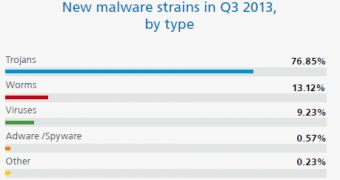Panda Security has published its Quarterly Report for the third quarter of 2013. The study focuses on malware, DNS poisoning attacks, mobile threats and NSA surveillance.
As far as malware is concerned, the figures show that almost 10 million new malware strains have been identified so far in 2013. This is already higher than the total number of malware strains spotted last year, which means that we’re seeing a new record.
Close to 77% of all new malware samples identified in the last quarter were Trojans, followed by worms (13%) and viruses (9%). Trojans were also responsible for most infections.
CryptoLocker is one of the most notable threats seen in the third quarter of 2013.
When it comes to mobile threats, Google’s Android platform continues to be the most targeted. However, experts note that some high-profile attacks have also been aimed at iOS.
The report also shows that cybercriminals have increasingly relied on DNS cache poisoning techniques to target major companies such as Google, Microsoft and various security solutions providers.
The NSA’s spying practices are also detailed in the latest report from Panda Labs.
“Everything seems to indicate that there will be more revelations about other NSA surveillance programs to indiscriminately spy on users, companies and governments around the world,” commented Luis Corrons, technical director of PandaLabs.
Experts found that Latin America remained the region most affected by malware. In China, almost 60% of computers were found to be infected with malware.
The lowest infection rates were recorded in European countries such as the Netherlands, the UK and Germany. For additional details, check out the complete Panda report for Q3 2013.

 14 DAY TRIAL //
14 DAY TRIAL //